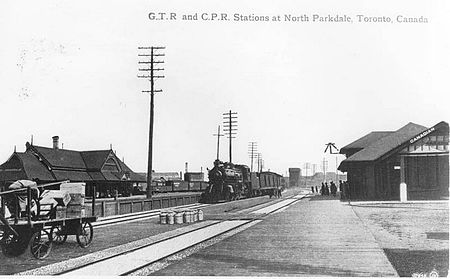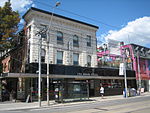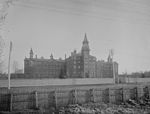Parkdale station (Toronto)
Buildings and structures demolished in 1977Canadian National Railway stations in OntarioCanadian Pacific Railway stations in OntarioDemolished buildings and structures in TorontoGrand Trunk Railway stations in Ontario ... and 5 more
Pages with no open date in Infobox stationRailway stations closed in 1976Railway stations in Canada opened in 1856Railway stations in Canada opened in 1879Railway stations in Toronto

Parkdale railway station or North Parkdale railway station as it was also known was a passenger train station in Toronto, Ontario, Canada. The station served the Parkdale village on the then-outskirts of Toronto. The station served trains on the Northern Railway of Canada and Credit Valley Railway, later the Canadian Pacific Railway, railways. It was situated at the intersection of Dufferin Street and Queen Street West. The train station was decommissioned in the 1970s.
Excerpt from the Wikipedia article Parkdale station (Toronto) (License: CC BY-SA 3.0, Authors, Images).Parkdale station (Toronto)
Joe Shuster Way, Toronto
Geographical coordinates (GPS) Address Nearby Places Show on map
Geographical coordinates (GPS)
| Latitude | Longitude |
|---|---|
| N 43.641944444444 ° | E -79.4275 ° |
Address
Joe Shuster Way 80
M6K 0A5 Toronto
Ontario, Canada
Open on Google Maps








